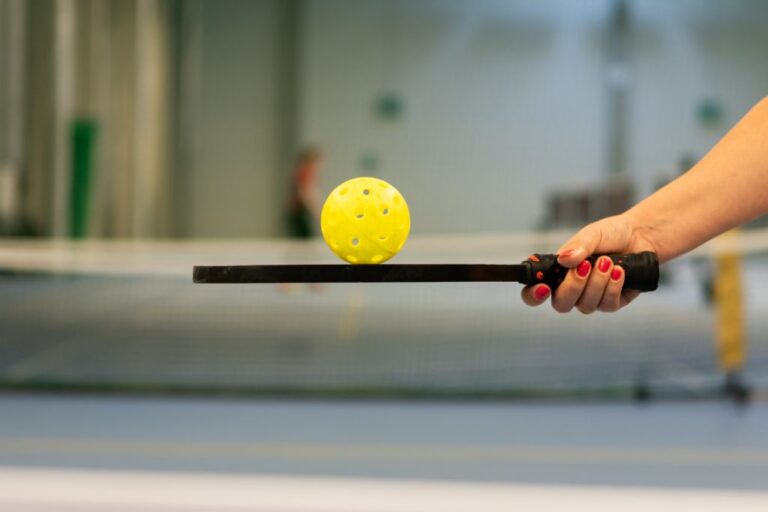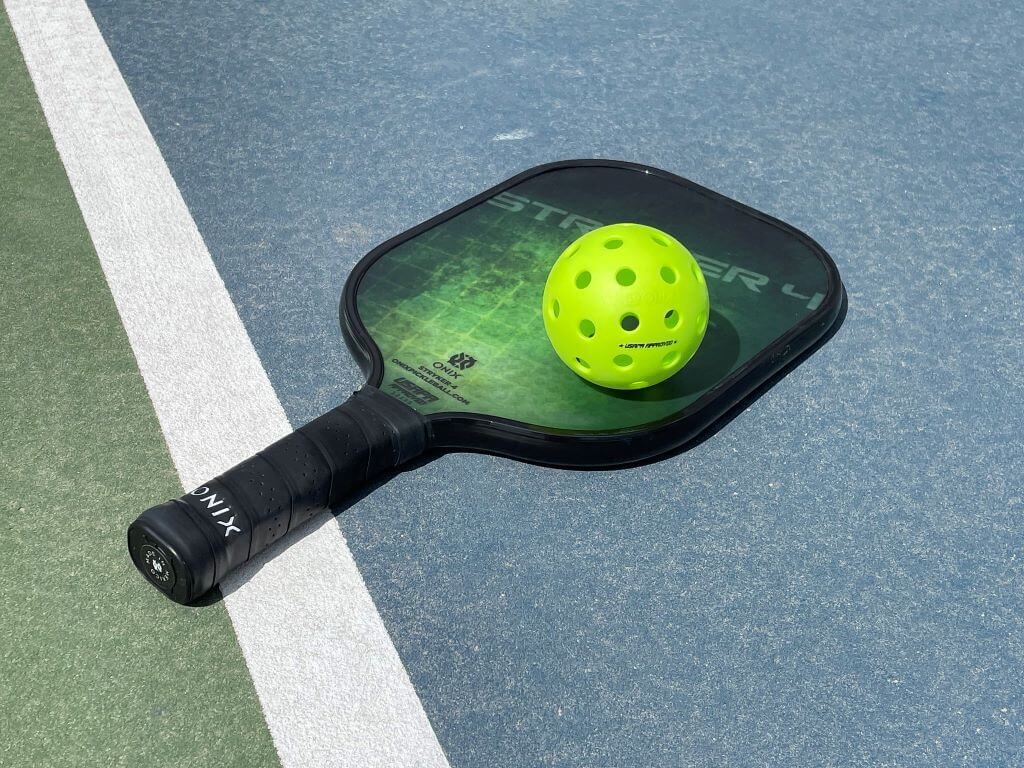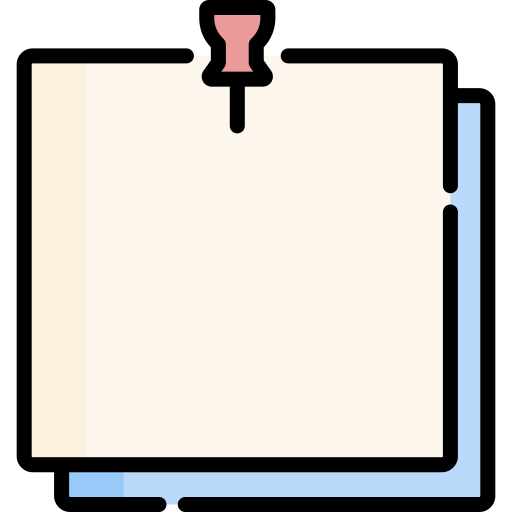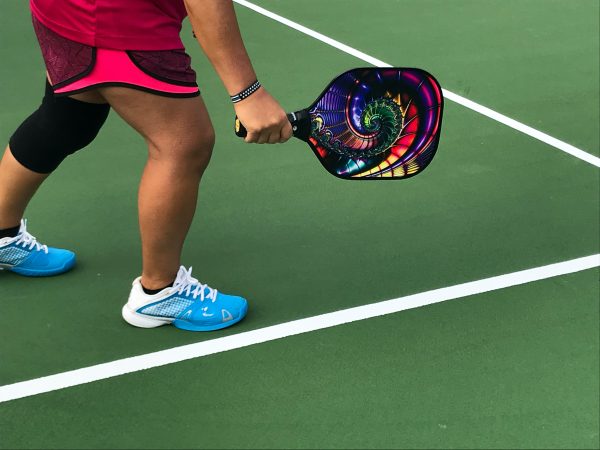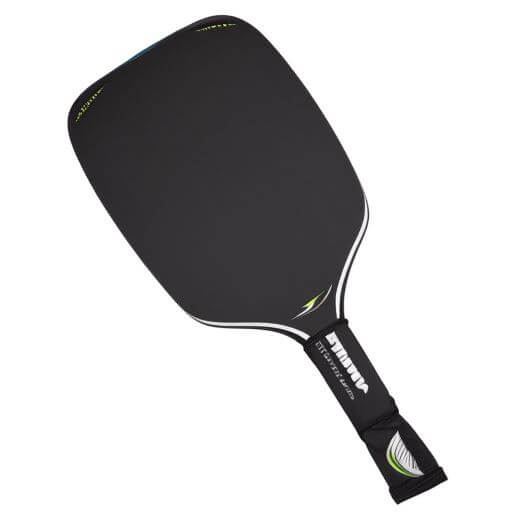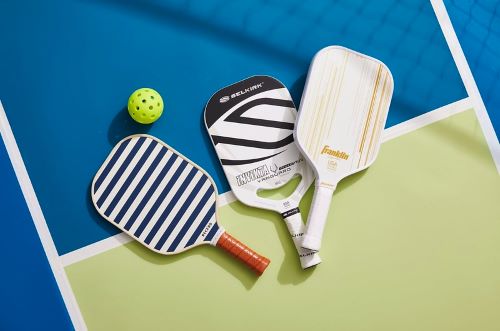With pickleball becoming the fastest-growing sport in America, there are more and more options to choose from when buying pickleball paddles.
If you’re new to the sport, you might be confused by the different kinds of pickleball paddles and the different sizes they come in. There are standard sizes, elongated pickleball paddles, and custom DIY paddles.
In this article, you’ll learn about all types of pickleball paddle sizes, what is allowed in tournaments, and more.
What Is the Standard Pickleball Paddle Size?
The USA Pickleball Association (USAPA) is the leading organization for all things pickleball. As such, it created the game’s official rulebook that’s followed by all recognized tournaments. According to the USAPA, there is a standard pickleball paddle size.
| Dimensions for Standard Pickleball Paddle | |
|---|---|
| Face size | 15.5 inches (39.4 cm) in length and 7 inches (17.8 cm) in width |
| Core thickness | 0.25 to 0.35 inches (6.4 to 8.9 mm) |
| Handle length | (Measured in Circumference) 4.5 to 5.5 inches (11.4 to 14 cm) |
| Handle weight | 1.5 to 2.5 ounces (42.5 to 71 g) |
These are the standard dimensions, but they aren’t the only dimensions allowed. The USAPA allows customized pickleball paddles that deviate from the standard dimensions, as long as they follow these criteria:
- The combined length and width, including any edge guard and end cap, shall not exceed 24 in (60.96 cm).
- The paddle length cannot exceed 17 in (43.18 cm).
Pickleball Paddle Anatomy: What Are the Parts Called?
A pickleball paddle is made up of different parts. Here’s a list of every single part of a pickleball paddle, complete with explanations of what these parts do and what they’re typically made of.
- Paddle face – This is the surface of the pickleball paddle that hits the ball during play. It’s primarily crafted from materials such as graphite, wood, or a carbon polymer to provide a balance between responsiveness and durability.
- Edge guard – Located around the periphery of the paddle’s face, the edge guard serves a protective role. It safeguards the face from damage and helps to retain the paddle’s shape over time and usage.
- Throat – Often composed of the same material as the paddle face, the throat is a structural component of the paddle that connects the handle to the face.
- Handle – The handle of a pickleball paddle is what the player grips during a match. Its construction often involves materials like wood, graphite, or a carbon polymer, chosen for their resilience and comfort.
- Grip tape – Also referred to simply as “the grip”, this component covers the handle to ensure a better hold. Most pickleball paddle grips are made of rubber or synthetic materials such as polyurethane (PU) to ensure a firm, comfortable grip.
- Core – The core of a pickleball paddle is its “heart”. It significantly influences the paddle’s performance characteristics such as power, control, and the overall feel of the paddle. Different types of cores include Nomex, polymer, aluminum, or wood, each offering unique advantages.
- End cap – The end cap, also known as the “butt cap”, is positioned at the base of the handle. Its function is to protect the handle’s end from wear and tear. It may also slightly extend the length of the handle. The materials used for end caps vary, but they are all designed to withstand intense gameplay.
Underrated: Pickleball Paddle Grip Size
The grip size or thickness of the handle is actually one of the most underrated but important factors when buying a paddle. A properly fitting grip provides more than just comfort—it directly impacts your playing style and even your health.
A grip that’s too small requires extra work on the hand muscles just to firmly grip the paddle. This leads to faster fatigue, cramps, and an increased risk of injuries. For example, tennis elbow is an injury that happens when the muscles in your elbows are too strained.
On the other hand, a grip that’s too large can be just as problematic. A larger grip is harder for quick wrist movements and fine adjustments during the game. You’ll struggle to hit quick shots and even control your swings for more accurate shots.
How to Know Pickleball Paddle Grip Size
Thankfully, finding your pickleball paddle grip size isn’t difficult at all. There are two main ways to do this—the first is the “tennis way” of testing, and the second uses a ruler.
The index finger test is a popular way of finding your grip for tennis rackets. However, you can do this for pickleball as well. Grip your pickleball paddle in your dominant hand, just like you would in a game. Then, try to fit the index finger of your other hand into the space between your dominant hand’s fingers and your palm. If your index finger fits snugly, then that grip is the right size. If there’s extra space or if it’s too tight, you might need to consider a different grip size.
If you’re looking for a more precise measurement, you can use the second method, which requires a ruler. Place the ruler’s base on the middle crease of your palm and measure the length to the tip of your ring finger. The middle crease is the middle line across your palm, or the bottommost line that’s horizontal. That’s the ideal grip size for your hand in diameter. Typically, this will range between 4 to 4 ½ inches for most adult players, so get a handle with the same circumference or grip size as that.
But what if you find out that your grip isn’t the perfect fit? Don’t worry. Adjusting your pickleball paddle grip size isn’t rocket science. You can change your paddle’s grip size with the help of a replacement grip or an overgrip.
Changing Your Pickleball Paddle Grip Size
If you find that your grip size is too small or too big, you can change it by adding or removing grip tape. This is a thin, rubberized tape that’s wrapped around the handle of the paddle. Having it on provides a better grip, which helps prevent the paddle from slipping out of your hand during matches.
This is the easiest way to add some extra girth to your handle. But, grip tape isn’t a one-stop shop. There are a lot of varieties. Some people prefer leather grips, cushioned grips, and even sweat-absorbing grips. So, it all depends on what you’re looking for and what you’re comfortable with.
Standard vs Elongated Pickleball Paddles
Elongated pickleball paddles were popularized around 2018. They’re longer than standard paddles, but also narrower by about an inch. This makes them a little bit heavier and more unwieldy than standard paddles, but they’re stronger and have a longer reach.
Size Difference between Standard and Elongated Pickleball Paddle
Standard pickleball paddles typically measure around 7 to 8 inches in width and 15 to 16 inches in length. On the other hand, elongated pickleball paddles are 6 to 7 inches in width and 16 to 17 inches in length.
Despite being significantly longer, the combined length and width of an elongated paddle still fits into the 24-inch combined limit set by the USAPA.
Sweet Spot Size of Standard and Elongated Pickleball Paddles
The sweet spot is the area on a paddle where the ball rebounds with the most speed and least vibration. Typically, this is the centermost part of the paddle face. On a standard paddle, the sweet spot is larger because of its wider face. This makes the paddle more forgiving and easier to use, especially for beginners.
In contrast, elongated paddles have a smaller sweet spot due to their narrower shape. Hitting the ball on its sweet spot requires more precision, but if done correctly, you will be able to deliver more powerful shots. This makes these paddles popular among intermediate and advanced players.
The Weight Difference Between Elongated and Standard Pickleball Paddles
Most standard pickleball paddles weigh between 6.5 to 8.5 ounces. This weight provides a good balance of power and control, making these paddles suitable for most types of play.
Elongated paddles, due to their slim design, typically weigh less at 6 to 7.5 ounces. The lighter weight allows for quick maneuverability and swift reactions, perfect for fast-paced games.
Here’s a comparison table to help you compare both easier:
| Feature | Standard Paddle | Elongated Paddle |
|---|---|---|
| Size | 15-16 inches long, 7-8 inches wide | 16-17 inches long, 6-7 inches wide |
| Sweet spot size | 3 inches in diameter | 2-3 inches in diameter |
| Weight | 7-10 ounces | 8-12 ounces |
| Power | Less powerful | More powerful |
| Control | More control | Less control |
| Best for | Players of all skill levels | Players who want to hit harder shots |
In summary, standard paddles are great for beginners who prefer a larger sweet spot and a good balance of power and control. Elongated paddles, with their extended reach, lighter weight, and stronger but smaller sweet spots, are perfect for advanced players seeking quick reactions and precision.
What Are the Sizes for A Custom Pickleball Paddle?
Custom pickleball paddle sizes can pretty much be anything. You can follow the standard pickleball paddle dimensions, or go for a more elongated or wider paddle. Anything goes as long as it fits within the criteria of the USAPA.
Keep in mind that custom-made pickleball paddles can be cheaper but are also generally heavier. This is because manufactured pickleball paddles use pretty complex systems to make the paddle face. They have to take into consideration the weight, the center of gravity of the paddle, and the rigidness of the paddle face even with a lightweight material.
This means creating faces using honeycombs and other kinds of patterns underneath. It also means finding the best mixture of materials for a strong but still flexible core. There’s a whole science in and of itself. There’s a good reason why wooden pickleball paddles are impossible to find in the professional scene.
What Does the Best Pickleball Paddle Look Like?
Unfortunately, there is no “best” pickleball paddle, because each player is different and prefers a different weight, balance, and material. That said, the best paddle is one that serves your strengths best. If you’re a player with powerful swings, an elongated paddle with a rigid surface will strengthen your shots even more.
Prefer classier, more accurate shots? Then the standard paddle with a lighter weight will be easier on your wrists, especially for quick shots near the net.
Popular Brands for Pickleball Equipment
Here are a couple of popular brands for pickleball equipment. If you’re interested in buying a new paddle, these three stores are the best places to start. They’ve made a name for themselves in other sports as well like tennis or racquetball.
Selkirk
Selkirk Sport is renowned for producing high-quality pickleball paddles that strike a perfect balance between power and control. Their paddles are recognized for their impressive durability, making them a hit among players who don’t want to worry about their gear breaking down in the middle of an intense game.
Selkirk paddles often feature advanced materials like graphite and polymer to deliver excellent performance in games. A standout aspect of Selkirk is its AMPED technology, which utilizes a thicker core for enhanced power and control.
You’ll find that Selkirk paddles tend to be on the pricier side. Yeah, you’ll be paying for excellent quality. But if budget is a concern, there are other brands that offer more affordable options.
PaddleTek
PaddleTek is another big name in the pickleball equipment industry. They’re best known for their Tempest line, which offers excellent touch and control. Many players appreciate the soft feel of PaddleTek paddles, which can help improve accuracy and shot placement.
PaddleTek paddles also often have a larger sweet spot than many of their competitors, making them a good choice for beginners or those working on improving their accuracy.
On the downside, players have expressed that PaddleTek paddles do not deliver as much power as some of the other brands. This could be a disadvantage for players who have heavy-hitting play styles.
Wilson
The Wilson is another well-established brand in the world of racquet sports whose venture into pickleball has been met with positive reviews. Wilson pickleball paddles are appreciated for their durability, reliability, and design.
They offer a range of paddles to cater to different playing styles and levels. The Wilson Tour paddle, for example, is known for its power and large sweet spot, while the Surge model offers excellent control and touch.
While the brand carries a reputation for quality, some players find Wilson paddles a bit heavy, which might not be ideal for smaller players or those seeking quick hand speed or play for extended periods.
What’s the Best Pickleball Paddle for Beginners?
The best pickleball paddle for beginners to practice with is always the standard one. We recommend getting a cheaper, more affordable paddle as a starter.
Being a beginner means you’re still figuring out your play style and strategies. The best way to do this is to go for standard paddles with medium-weight, medium-size, and medium-quality materials. Pickleball paddles can last quite a while—around six months if you play five days out of seven, and possibly two years if you’re just a casual player.
So getting an expensive paddle right off the bat is a great way to waste money and get stuck with a paddle that doesn’t even suit your playstyle.
Pickleball Paddle Size versus Other Sports?
If you’re curious to know how well the pickleball paddle sizes up against other paddles and rackets from other sports, here’s a comparison table.
| Sport | Length | Width | Weight | Grip Size |
|---|---|---|---|---|
| Pickleball | 15-17 inches | 7-8 inches | 7-12 ounces | 4 1/2 – 5 inches |
| Tennis | 27-29 inches | 10.25-11.25 inches | 10-14 ounces | 4 – 4 1/2 inches |
| Ping Pong | 15.25 inches | 6.5 inches | 6-8 ounces | 4 – 4 1/2 inches |
| Badminton | 26-28 inches | 9-10 inches | 8-10 ounces | 4 – 4 1/2 inches |
Pickleball paddles are the 2nd smallest in size after the ping pong racket. This makes sense considering ping pong is played on a table and not on a court.
Find the Best Pickleball Paddle Size for You
Finding the best pickleball paddle size for you is all about understanding your playstyle.
If you’re the kind of person who wants stronger shots and more reach, elongated pickleball paddles are the best in the sport for these kinds of players. Want more finesse, control, and precision? Standard paddles might not hit the strongest, but they’re lighter, making you return faster and be more nimble.
For beginners, we recommend borrowing from a friend or trying a few rented pickleball paddles first. You’ll be able to get a good feel of the game and the different paddles, both of which can help you decide on the best paddle to buy for you.

